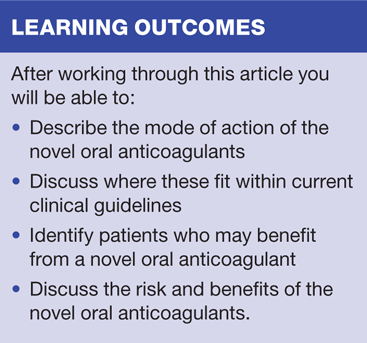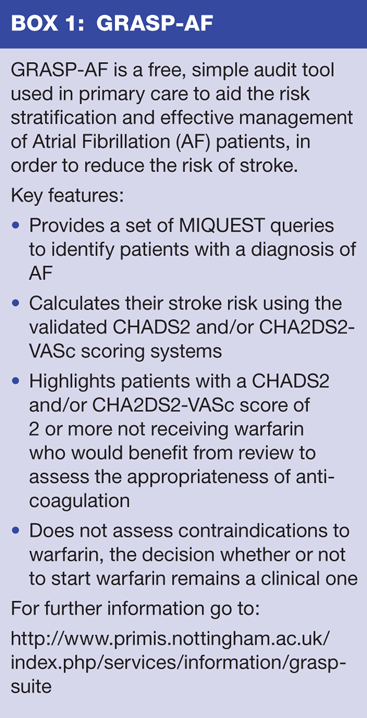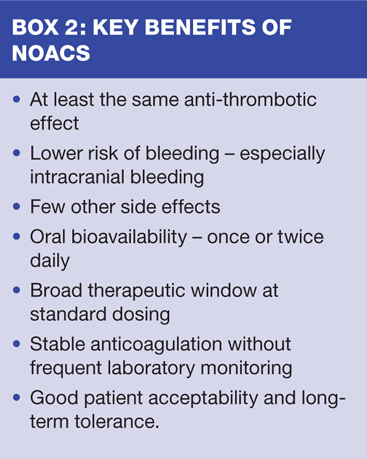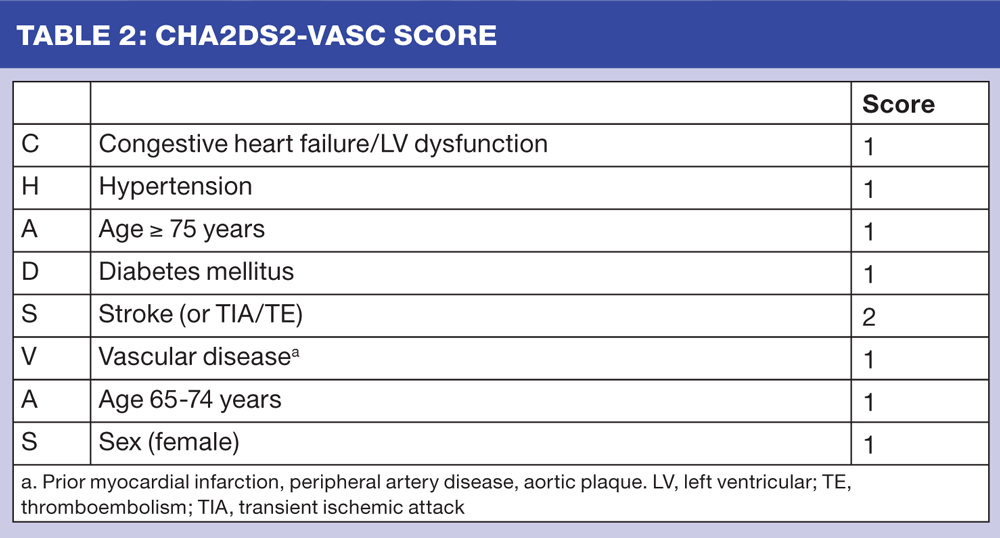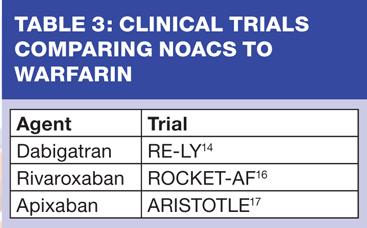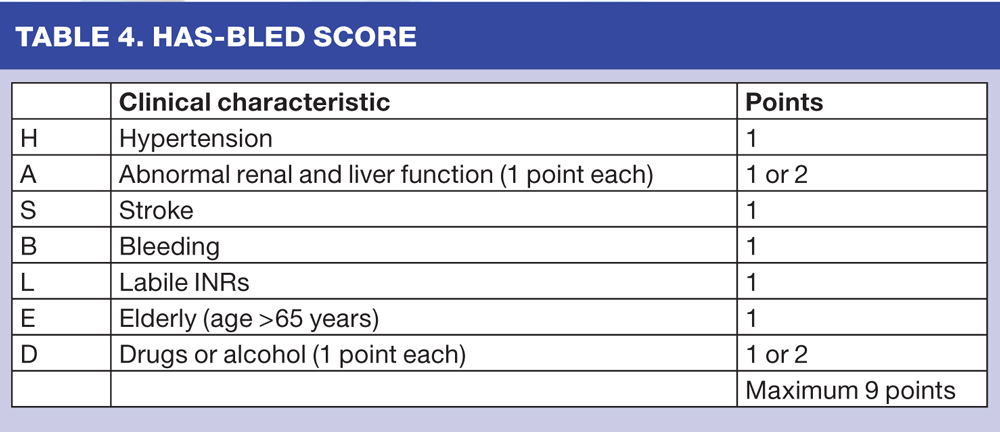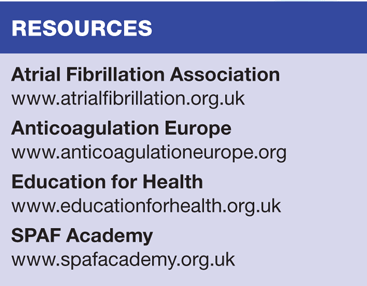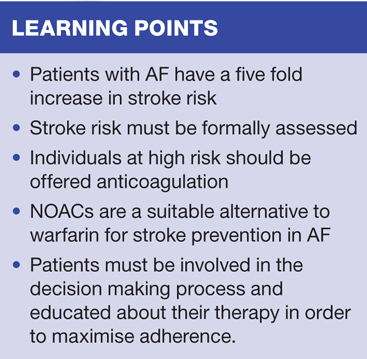Novel oral anticoagulants: where they fit in clinical practice
Joanne M Haws
Joanne M Haws
RN MSc
Independent Nurse Consultant in Cardiovascular Disease
Clinical Trainer, Education for Health
A number of new options for anticoagulation are now available. How do these new agents work and what is their role in clinical practice?
The introduction of the novel oral anticoagulants (NOACs) as an alternative to vitamin K antagonists is a potentially exciting development, both for patients and the clinicians managing their care.1 For many years warfarin has been the only option for long-term prevention of thrombo-embolic events in high-risk patients and, in many clinical conditions, is worryingly under-prescribed.2 The key indication for the NOACs is for stroke prevention in non-valvular atrial fibrillation (AF), although one of these new agents has further licensing indications within the spectrum of thrombo-embolism prevention.
HOW NOACs WORK
There are currently three NOACs licensed for use in the UK:
- Dabigatran
- Rivaroxaban
- Apixaban
The role of the enzyme thrombin is to convert soluble fibrinogen to the non-soluble fibrin strands that make up the fibrin-rich clots implicated in AF-related stroke.3 Dabigatran acts on the coagulation cascade by directly inhibiting the action of thrombin.
Rivaroxaban and apixaban are Factor Xa inhibitors. Through inhibition of Factor Xa these agents interrupt both the intrinsic and extrinsic pathway of the coagulation cascade, inhibiting the formation of thrombin and therefore the development of blood clots.4
ATRIAL FIBRILLATION
AF is the most common, sustained cardiac arrhythmia and, if left untreated, is a significant risk factor for stroke and other morbidities.
In AF the fibrillating atria are susceptible to the formation of thrombi that may embolise, usually from within the left atrium and specifically the left atrial appendage, and enter the circulatory system. Anatomically the most convenient and common route for a thrombo-embolism to take from the left atrium is through the carotid arteries to the mid brain, with potentially catastrophic consequences for the patient. The risk of stroke is increased five-fold in those with AF and these strokes are often very severe and disabling.5
STROKE RISK ASSESSMENT
Assessing stroke risk in individuals with AF is essential and is included in the Clinical Indicators of the Quality and Outcomes Framework (QOF) for general practice.6
The CHADS2 score is a clinical prediction tool allowing assessment of annual adjusted stroke risk in individuals with AF by inclusion or exclusion of key risk factors (Table 1).7 The score has now been refined to form the more comprehensive risk score CHA2DS2-VASc which incorporates additional risk factors and places a greater emphasis on advancing age (Table 2).8 Individuals with AF should be assessed on diagnosis and re-assessed annually. Those at high risk of stroke, with a score on either tool of greater than 1, should be considered for anticoagulation.
ASPIRIN
Many patients with AF will have been given aspirin for stroke prevention. Indeed, this was an option recommended for lower risk patients in the 2006 NICE Guidelines for Atrial Fibrillation. Although it is largely accepted that aspirin is less effective than warfarin in stroke prevention, offering approximately 20% risk reduction compared to around 60% with warfarin, it has widely been regarded as a 'safer' option. The BAFTA study dispelled this myth by demonstrating similar bleeding rates amongst older people assigned to either warfarin or aspirin, alongside significantly inferior stroke protection with aspirin.9
Although the NICE guidelines have yet to be updated the 2012 European Society of Cardiology (ESC) guidelines are clear that there is no role for aspirin use in the routine prevention of strokes in AF.10
WARFARIN
Warfarin is the most commonly prescribed anticoagulant in the world. Its discovery dates back to the prairies of Northern America in the 1920's where many cattle died of haemorrhage linked to their 'sweet clover hay' diet. In 1945 the idea of using a derivative of coumarin, the active substance in sweet clover, as a rodenticide was developed. Thus begins the story of warfarin, still referred to as 'rat poison' by patients, and some clinicians, today.11
It is, perhaps, this association with rat poison that contributes to the often-negative view of this under-prescribed, life-saving drug. The decision to introduce warfarin can be difficult for both clinician and patient. There is a perceived risk of bleeding, and patients need regular monitoring. There are also concerns about the possible impact on the individual's lifestyle. Given that AF is most common in older people with other cardiovascular co-morbidities and much to deal with it is perhaps understandable that there may be reticence on both sides. The fact remains, however, that AF related strokes are both devastating and highly preventable.
USE OF ANTICOAGULANTS IN AF
In 2006 NICE estimated that almost half of high-risk AF patients were not anticoagulated. The reasoning behind this has been widely debated and is likely to be multi-factorial, including reticence of prescriber and patient, availability of monitoring services and the frailty of many AF patients. If high-risk AF patients were appropriately anticoagulated, it is estimated that 6,000 strokes and 4,000 lives could be saved each year in the UK.12 There is now a national effort to improve anticoagulation rates. Resources, such as GRASP-AF, (Box 1) are designed to help clinical teams achieve this.
NICE suggests that warfarin should remain the first line treatment for stroke prevention in AF with the aim of achieving a therapeutic range (TTR) that produces an INR of between 2 and 3. It is essential that, in addition to monitoring dosage effect through INR, a broader view is taken of the time spent within TTR. Generally the evidence suggests that patients should spend at least 60% of the time within TTR in order to receive the full benefit of anticoagulation in terms of stroke reduction and to minimise the risks associated with warfarin. Local guidelines on this may vary slightly.13
Through its technology appraisals of NOACs, NICE suggests that these new agents, within their licensed indications, should be made available to patients who are unsuitable for warfarin.
THE EVIDENCE FOR NOACs IN STROKE PREVENTION IN AF
Although the use of NOACs for stroke prevention in AF looks highly promising they are still very new to clinical practice in the UK and experience needs to be gained in their use, by both clinicians and patients.1
Clinical trials on the three licensed agents have demonstrated non-inferiority to warfarin, which means that they have been proven to have at least the same anti-thrombotic effect as warfarin, and one agent was shown to be superior to warfarin (Table 3). The key benefits of NOACs are their predictable effect without the need for monitoring, fewer food and drug interactions, shorter plasma half-life and an improved efficacy/safety ratio (Box 2).
The RE-LY study of dabigatran showed that, relative to warfarin, dabigatran 110 mg twice daily was associated with a similar rate of stroke reduction and a lower rate of bleeding, whereas dabigatran 150 mg twice daily reduced stroke as well as life-threatening bleeding compared to warfarin.14
The ROCKET-AF study found that rivaroxaban 20mg daily was non-inferior to warfarin for reducing stroke or systemic embolism and had less hemorrhagic strokes, systemic embolism and bleeding (critical, fatal and intracranial) versus warfarin, though was associated with an increase in minor bleeding.16
The ARISTOTLE trial for apixaban, the latest NOAC to be approved for use in the UK, demonstrated that apixaban 5mg twice daily was superior to warfarin for reducing stroke or systemic embolism and had a reduced bleeding and discontinuation rate compared with warfarin.17
COMMENCING OR SWITCHING TO NOAC
The rationale for considering switching from warfarin to a NOAC includes suboptimal TTR, interactions and patient choice. Patients who are stable on warfarin therapy should remain on it.
Counselling and review
Before a NOAC is prescribed the potential risks and benefits of anticoagulation in general, and the choice of specific agent must be carefully considered and discussed with the patient. As with warfarin, patients treated with a NOAC should be fully counselled and carry details about their anticoagulant therapy with them, to alert healthcare professionals who may be involved in their care. There is currently no standard equivalent of the 'yellow book' used with patients taking warfarin although the European Heart Rhythm Association has proposed a universal new oral anticoagulation card that could serve all patients treated with a NOAC.
It must be stressed that treatment with a NOAC still requires vigilance, particularly in the largely older and potentially frail patients likely to be prescribed these drugs. Although NOACs do not require frequent tests in the form of coagulation monitoring it is recommended that patients are reviewed regularly, ideally on a 3-monthly basis, to discuss adherence and any signs of bleeding or side effects, in addition to any renal function monitoring the specific agent requires. Many patients with AF may also have chronic kidney disease (CKD), in addition to other cardiovascular co-morbidities. It should be noted that NOACs are suitable for use in mild to moderate CKD but may require a reduced dose in these patients. Guidance for NOAC use in patients with CKD varies between agents, therefore suitability and dose adjustments should be made on an individual patient and drug-specific basis.1 Practice nurses, given appropriate training and clinical support, are ideally suited to undertake routine reviews of patients taking a NOAC.
Switching between therapies
The key fact to remember when switching from aspirin or warfarin is that the NOACs have a rapid onset of action. Patients may therefore be at increased risk of bleeding from the effects of more than one agent at the time of switching.
Patients with a high stroke risk who are currently receiving aspirin should be considered for anticoagulation. Switching from aspirin to a NOAC is straightforward. The patient should stop their aspirin on one day and commence their NOAC on the next. It is vital that the role of aspirin in the patient's therapy regime is fully assessed as they may require anti-platelet treatment for other reasons, such as coronary artery disease. For some patients dual therapy may be appropriate but the risks and benefits of this should be explored in each individual case. The HAS-BLED bleeding risk tool18 may be helpful in the decision making process. A score of 3 or more, while not an absolute contraindication to anticoagulation, indicates increased one year bleed risk on anticoagulation sufficient to justify caution or more regular review (Table 4).
Switching from warfarin to a NOAC requires more attention due to the increased bleeding risk during the switching process. NOACs start to work quickly whereas the effects of warfarin wear off slowly.
Each specific agent will have guidance for switching in the summary of product characteristics (SmPC) though in summary, clinicians should be looking for a reducing INR ratio of around 2.0 prior to commencing the NOAC.1
ADHERENCE
The anticoagulant effect of NOACs diminishes between 12 and 24 hours from the last dose. It is therefore vital that patients adhere to their dosing regime if they are to be protected against stroke. As with warfarin, patients should be fully counselled on the importance of adherence and be encouraged to discuss any issues, either at their routine review or earlier. Guidance from the European Heart Rhythm Association suggests that patients should be asked to bring their remaining tablets along to their review to help with adherence monitoring. If low adherence is suspected or confirmed, patients could be reconsidered for warfarin therapy, following appropriate education, where effects can be monitored.1
ADVICE ABOUT BLEEDING
One of the major concerns about NOACs has been the lack of reversal agents or 'antidotes'. Manufacturers are currently developing these but at the moment there is limited evidence-based, practical advice on bleeding management.
Important factors to remember are:
- NOACs largely have a more favourable bleeding profile compared to warfarin, and
- Their anticoagulant effect wears off rapidly compared to warfarin.
Patients should be encouraged to report any bleeding and advised on local haemostatic measures in line with general first aid advice. Potentially life-threatening bleeding requires emergency treatment, and patients and relatives should be advised about calling for help on initiation of a NOAC. For patients requiring surgical intervention it is usually appropriate to miss one or two doses of their NOAC and recommence post-operatively in line with the product SmPC.1
CONCLUSION
NOACs are a useful alternative to warfarin for patients with non-valvular AF. They are relatively new drugs and further experience is needed in their use. NICE has defined the role of the individual NOACs through their technology appraisal process and their use is expected to increase over the next few years.
Healthcare professionals are right to exercise due caution with new medicines but this should not inhibit them from prescribing these potentially life-saving treatments when appropriate. Patients with AF have a five-fold increase in stroke and this can be reduced dramatically with appropriate anticoagulation. Anticoagulation rates in the UK remain lower than expected and this needs to be improved upon. Tools such as CHADS2, CHADS2-VASc and GRASP-AF can help identify and prioritise patients for review and the HAS-BLED score can be very helpful in the decision making process. Where healthcare professionals do not feel confident with anticoagulation they should have access to appropriate education and training to improve their practice.
An AF-related stroke may have catastrophic consequences for a patient and will threaten their life and independence. Healthcare professionals have a duty to identify patients at risk and offer treatments to protect them against such devastating and costly events.
NOW TEST YOUR KNOWLEDGE BY COMPLETING THE SELF-ASSESSMENT BELOW
SELF-ASSESSMENT
Consider the following scenarios, discuss with your colleagues and answer the questions. A discussion of the correct answers appears at the end of this article, after the references.
SCENARIO 1
A 72-year-old lady attends for her annual CHD review. She has been in AF for three years and has been taking warfarin since being diagnosed. She attends regularly for INR monitoring and has had very few problems with her warfarin therapy. When reviewing her medication you consider whether she might be suitable for a NOAC. What would be your next steps?
a) Ask if she would be interested in changing from her warfarin
b) Send her to her GP to discuss her warfarin
c) Assess her time in therapeutic range (TTR) and explore any issues with side effects and interactions
d) Leave her on warfarin.
SCENARIO 2
A 63-year-old man attends for a hypertension review and is found to be in AF. His records show he has been in AF for 18 months. He has previously declined warfarin as he travels extensively and the logistics of INR monitoring would not fit in with his lifestyle. He has heard about the new alternatives to warfarin and wonders if this might be for him.
What advice would you give?
a) Agree that he may be suitable for a NOAC and arrange for baseline renal function tests to be carried out
b) Explain that these are new expensive drugs and you are not yet using them in your practice
c) Discuss the risks and benefits of the NOACs within your level of competence or refer to an appropriate colleague
d) Suggest he discuss with his GP next time he visits.
SCENARIO 3
You are conducting a review of the long-term conditions of a frail 92-year-old lady in her home. She has moderate heart failure, type 2 diabetes and osteoarthritis, and is becoming increasingly forgetful. She has been prescribed a large cocktail of different drugs for these conditions and her niece pops in daily to check she is OK. She is known to have AF and her stroke risk assessment shows her to be high risk.
Should she be anticoagulated?
a) No, she may have a fall and bleed
b) The risks and benefits of anticoagulation should be considered and if appropriate discussed with the patient and her niece. An individual and informed decision can then be made.
c) Give her aspirin.
SCENARIO 4
A 58-year-old man with AF has been taking aspirin 150mg daily for stroke prevention. He has a CHA2DS2-VASc score of 2 due to his history of hypertension and previous DVT.
How should you approach anticoagulation with him?
a) His risk of stroke should be fully explained and options for anticoagulation discussed
b) He should be commenced on a NOAC
c) He should remain on his higher dose of aspirin
d) He should be reassessed using CHADS2, which will reduce his risk score.
SCENARIO 5
A 71-year-old lady with AF has been taking warfarin for 3 years and has poor control. Despite regular counseling she has trouble managing her diet to avoid food interactions and is struggling to pay the frequent taxi fares to attend for INR monitoring. She insists that she adheres to her warfarin and has well-controlled hypertension. Her sister suffered a stroke and died 2 years ago and she is terrified she will meet the same fate.
How can you help her?
a) Refer her to a dietician
b) Take her off warfarin and offer aspirin instead
c) Ask the district nurses to take on her INR monitoring at home
d) Assess her suitability for a NOAC.
REFERENCES
1. Heidbuchel H, Verhamme P, Alings M, et al. EHRA Practical Guide on the use of new oral anticoagulants in patients with non-valvular atrial fibrillation: executive summary. Eur Heart J 2013 doi: 10.1093/eurheartj/eht134
2. NICE. Atrial Fibrillation: the management of atrial fibrillation. CG 36. 2006 NICE. London
3. Hankey GJ, Eikelboom JW. Dabigatran etexilate: a new oral thrombin inhibitor. Circulation 2011; 123: 1436-1450
4. Samama SM. The mechanism of action of rivaroxaban — an oral, direct Factor Xa inhibitor —compared with other anticoagulants. Thromb Res. 2011;127(6):497-504
5. Lip GY, Lowe GD. ABC of atrial fibrillation. Antithrombotic treatment for atrial fibrillation. BMJ 1996; 312:45.
6. British Medical Association. Quality and Outcomes Framework guidance for GMS contract 2013/14. 2013. BMA. London
7. Gage BF, Waterman AD, ShannonW, et al. Validation of clinical classification schemes for predicting stroke: results from the National Registry of Atrial Fibrillation. JAMA 2001;285(22):2864-70.
8. Lip GY, Nieuwlaat R, Pisters R, et al. Refining clinical risk stratification for predicting stroke and thromboembolism in atrial fibrillation using a novel risk factor-based approach: the Euro Heart Survey on atrial fibrillation. Chest 2010;137(2):263-72.
9. Mant J,Richards S, Hobbs FDR, Fitzmaurice D, et al, for the Midlands Research Consortium of General Practice. Protocol for Birmingham Atrial Fibrillation Treatment of the Aged study (BAFTA): a randomised controlled trial of warfarin versus aspirin for stroke prevention in the management of atrial fibrillation in an elderly primary care population. BMC Cardiovasc Disord. 2003; 3: 9
10. ESC Taskforce on Atrial Fibrillation. An update of the 2010 ESC Guidelines for the management of atrial fibrillation. Eur Heart J 2012; 33:2719—2747
11. Wardrop D, Keeling D. The story of the discovery of heparin and warfarin. B J Haematol 2008;141:757—763
12. NICE. Anticoagulation therapy service Commissioning guide: Implementing NICE guidance. 2007. NICE. London
13. Apostolakis S, Sullivan RM, Olshansky B, Lip GYH Factors affecting quality of warfarin anticoagulation in patients with atrial fibrillation: insights from AFFIRM. Heart 2012;98:A32 doi:10.1136
14. Connolly SJ, Ezekowitz MD, Yusuf S, Eikelboom J, Oldgren J, Parekh A, et al. RE-LY Steering Committee and Investigators Dabigatran versus warfarin in patients with atrial fibrillation. N Engl J Med 2009;361(12):1139—1151.
15. Connolly SJ, Ezekowitz MD, Yusuf S, Eikelboom J, Oldgren J, Parekh A, et al. The Long-Term Multicenter Observational Study of Dabigatran Treatment in Patients With Atrial Fibrillation (RELY-ABLE) Study. Circulation 2013;128:237-243
16. Patel MR, Mahaffey KW, Garg J, et al. (ROCKET AF investigators). Rivaroxaban versus warfarin in nonvalvular atrial fibrillation. N Engl J Med 2011; DOI:10.1056/NEJMoa1009638.
17. Granger CB, Alexander JH, McMurray JJV et al. Apixaban versus warfarin in patients with atrial fibrillation. N Eng J Med 2011; DOI:10.1056/NEJMoa1107039
18. Pisters R, Lane DA, Nieuwlaat R, de Vos CB, Crijns HJ, Lip GY. A novel user-friendly score (HAS-BLED) to assess one-year risk of major bleeding in atrial fibrillation patients: The Euro Heart Survey. Chest 2010;138:1093-100
DISCUSSION
Scenario 1
C. If the patient is stable, well controlled and satisfied with warfarin there is no reason to switch to a NOAC. Her TTR should be reviewed and if she is within her TTR >60% of the time (or local guidance variation) she should remain on warfarin. If she has a suboptimal TTR or is having problems with side effects or interactions these should be explored and education offered where appropriate. If there is no improvement following intervention she should be considered for NOAC therapy.
Scenario 2
A & C. If the patient is attending for hypertension review it is likely he will be having routine renal function tests but if not this should be done before considering a NOAC. The risks and benefits of all anticoagulation therapy should be discussed with the patient by an appropriately informed healthcare professional and anticoagulation commenced without delay if appropriate. It must be explained to the patient that he will still need to attend for regular review although coagulation monitoring is not required with a NOAC
Scenario 3
B. This patient is frail and elderly with multiple long-term conditions and polypharmacy. It is right to consider her health conditions and medications alongside her quality of life and practical issues. Her age does not rule out anticoagulation but the risks and benefits should be carefully explored taking into account her wishes.
If there are concerns about the potential for bleeding, aspirin is not a safer alternative and should not be considered. The BAFTA study demonstrated inferior stroke prevention with aspirin but similar bleeding rates compared with warfarin.
Scenario 4
A. This patient is at increased stroke risk and should be anticoagulated. Warfarin or a NOAC would be suitable choices and an informed decision should be made following appraisal of the evidence and local guidance, taking into account patient choice.
There is no evidence that a higher dose of aspirin is any more effective in stroke prevention and may carry a higher bleeding risk. There is no rationale for reassessing with CHADS2 as CHA2DS2-VASc has been shown to be a more comprehensive tool.
Scenario 5
D. Having poor coagulation control on warfarin reduces its efficacy in terms of stroke prevention and, in many cases, the bleeding risks may then outweigh the benefits of the drug. It may be helpful to discuss this lady's case with a dietician but it seems that efforts have been made to support her with food choices. She is understandably afraid of having a stroke and appears to be adherent to her medication. She is likely to be a good candidate for a NOAC.
Related articles
View all Articles

